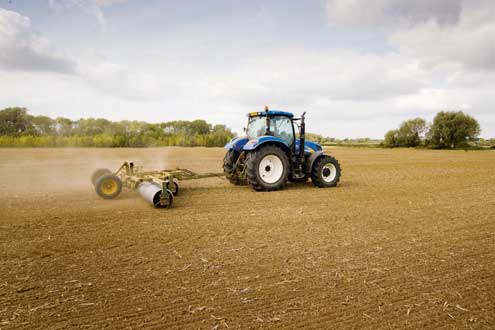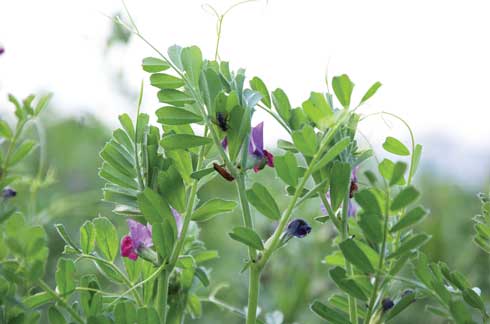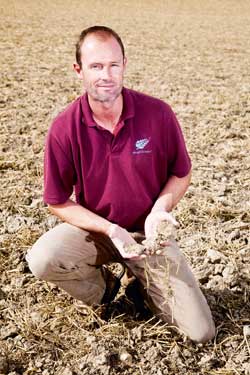Establishment is key to cover crop success

If you’re a cover crop convert, you’ll probably already have bought your seed. You’ll know from experience what suits your soil type and cultivation regime, be it direct drilling or min-till.
Growers struggling with the decision on which cover crop to grow should think about why they are establishing it, and then question how it will affect their other crops, suggests Stephen Briggs of Abacus Organic Associates.
“There are so many crops available as cover, or green manure, that it is best to focus on what it is you want to do with it. Is its main purpose to boost nitrogen levels in the system or to build organic matter and thus aid soil structure? If it is both, you can opt for a mixture.”
Most species can help to prevent nitrate loss over the winter by using soil reserves, but only legumes add to the levels already in the system. Vetch, lucerne and many species of clover offer up to 150kgN/ha a season, though be prepared for a slowdown in N production when the temperature drops below 8C, he warns.
“There are several frost-tolerant vetches, for example, that put on biomass quickly in a moist autumn and can fix nitrogen through the season. You can get 75-100kg N/ha, worth about £25/ha at today’s fertiliser prices, if you get it in by early September and leave it in through to late spring,” says Mr Briggs.
If the cover crop must be out in time for early spring crop establishment, and the main aim is to mop up N that could be leached, consider grazing rye, Westerwolds ryegrass, phacelia or mustard. The latter two can be killed off by winter frosts, though that is an advantage when drilling the spring crop without first cultivating, he says.
A mixture of species often works well, bringing the range of benefits and reducing the risk of failure if frost comes early. Some popular choices are grazing rye with vetch (pictured below), phacelia with vetch and winter beans with mustard.

But first ask yourself another important question, what else are you growing in the rotation? Be aware of the risks of putting your other crops under pressure by introducing a cover crop that could form a green bridge for pests and weeds between this autumn and next spring or summer, warns Mr Briggs.
“If cereals are your dominant crop, avoid rye, ryegrass and the like, and opt for a purely broad-leaved mixture. If you grow oilseed rape, rye and vetch would be safer than brassicas such as mustard and fodder radish. Remember that vetch is a type of pea, so it’s a no no where pulses are grown, to avoid sclerotinia carryover.”
Matching the crop to soil type is less important, since most species should take well, provided the soil isn’t acidic, he adds. Legumes such as vetch and clover often struggle in low pH soils, and lucerne requires a free-draining, high pH soil to grow well.
Cost
Keeping the cost down is key to maximising your return, so while rye with vetch mixtures can be highly productive, they can cost about £120/ha at the 100kg/ha recommended seed rate, warns Mr Briggs.
Where possible, he would use homegrown seed. Following a cereal, he recommends a good N fixing mix of winter beans and mustard, the former shallow drilled at a rate of 100kg/ha and the mustard broadcast on soon after at 3-4kg/ha. The total seed cost would be just £24/ha.
“You may find beans and mustard are killed when temperatures dive, but that simplifies management and hopefully you’ll have made some nitrogen by then. Plus there’s the organic matter – you can’t put a price on the value of soil improvement.”
The New Farming Systems (NFS) project, funded by the Morley Agricultural Foundation and the JC Mann Trust, is examining how novel “bi-crop” cover cropping might contribute to fertility building in arable systems.
Ron Stobart of NIAB TAG explains: “Small-leaved white clover seed was broadcast one season into a winter wheat stubble in mid-August. It delayed drilling a little that year, but now it re-establishes annually by natural regeneration. While there is an interaction with the nitrogen rate used, our research is now showing this approach can add up to an average of £84/ha to the margin over nitrogen.”
Mr Stobart acknowledges these crops are not direct drilled – shallow, non-inversion tillage takes place leading in to the winter and spring crops in different rotations – and blackgrass is not a threat. But he is impressed by clover’s resilience after herbicide applications, including glyphosate, to the cereals.
Other cover crop options in min-till situations in the trial are giving a slightly lower economic return, offering margins of about £70-80/ha. That equates roughly to the cost of their seed and establishment in many cases.
But as time progresses, there are additional advantages, relevant also to no-till systems – the residual organic matter, weed competition and insurance against winter soil erosion and nutrient loss. It looks even more attractive where you can secure support from an environmental scheme, he stresses. (The EJ13 cover crop option within the five-year ELS scheme earns 65 points).
Management
Choosing crop types that you don’t regularly grow on the farm can complicate management and the learning curve can be steep. But if you go with something that suits your soil type, conditions and farming system, you’ll find most species are relatively easy to establish, says Mr Stobart.
Optimum seed rates (see table below) can be trimmed where mixtures are used to spread the crop failure risk. He is a fan of seed mixes, but urges caution where seed sizes are very different. It can make sowing difficult, particularly where broadcasting, and unless carefully chosen, some species may dominate.
To get cover crops off to a flying start, moisture is critical, he stresses. “To make best use of available soil moisture, sow as soon as possible after harvest. Broadcasting works in many situations and rolling is a must.”
| Grazing rye with vetch | Phacelia | Mustard | Westerwolds ryegrass | |
|---|---|---|---|---|
| Pros and cons | N fixer at low temps (vetch), frost tolerant, expensive seed | Attractive to insects, poor frost tolerance, inexpensive seed | Good biomass to compete with weeds, poor frost tolerance, inexpensive seed | Fast organic matter builder, frost tolerant, relatively expensive seed |
| Seed rate | 100-150kg/ha | 10kg/ha | 15-20kg/ha | 30-40kg/ha |
| Sowing date | Late August to early September | Late August to early September | By late September | By late October |
| Establishment technique | Direct drill and roll | Broadcast or direct drill and roll | Broadcast and roll | Direct drill and roll |
| Depth of seed | 10-20mm | 1-4mm | 1-2mm | 10mm |
| Management | Cut before flowering (not vetch when grown alone) | No need to cut (frost usually kills it) | If necessary, cut before flowering (frost usually kills it) | Graze or cut before flowering ends |
Andy Barr
East Lenham Farm, Kent
 Kent grower Andy Barr blames delayed planting for not getting the most out of his early cover cropping experiments. But his “try it and see” approach is paying off and he is reaping the benefits of better soil structure and more organic matter.
Kent grower Andy Barr blames delayed planting for not getting the most out of his early cover cropping experiments. But his “try it and see” approach is paying off and he is reaping the benefits of better soil structure and more organic matter.
About 90% of crops are direct drilled on the 450ha arable area of East Lenham Farm, which also supports sheep. Mr Barr has replaced his Horsch drill with a Dale Eco-Drill, which moves less soil and allows better retention of moisture in the sandy soils. Last autumn, he saved a considerable amount of money using it to drill wheat into the rape stubbles and to establish cover crops.
“We had a kind, dry first autumn with the new kit. I hope this season will allow good establishment of a low-cost seven-seed mix in front of spring barley, and summer vetch ahead of of spring oats.”
He steers clear of grasses and brassicas to avoid rotational issues. The vigorous cover species offer their own form of weed control through competition and, in the case of vetch, some beneficial residual chemical effect for the following crop.
With soil moisture abundant this autumn, Mr Barr believes there will be an art to harvesting main crops and then direct drilling all covers by mid-September without jeopardising the timeliness of cereal drilling.
“The key to success is to use cheap seed and get it in early to maximise growth. I aim to spend no more than £40/ha on seed and establishment, even though NIAB TAG trials suggest cover cropping is economic beyond that.”
Home-saved oat seed is only £20/ha. Vetch is more costly, but he likes the returns from N fixation, estimated at an impressive 180kg/ha when grown to maturity. He will get a better idea of shorter-term fixation by using a soil mineral N test this year. Always keen to experiment, he’ll cut the seed rate from 50kg to 40kg/ha this autumn and compare winter and summer varieties.
He sees summer vetch’s frost sensitivity as an advantage, because it dies off in the spring, possibly saving the need to spray it off with glyphosate. Also, allowing his sheep to graze can be useful, both for the animals and for easing subsequent drilling.
“I try to spray off the cover crops at least a month prior to drilling to aid trash management and ensure we’re not planting into a lot of dying greenery. Another option is to drill direct into the living cover with a disc drill and then spray off pre-emergence of the main crop, but I’m not there yet.
“We will experiment this season with further management of the covers, for example by spraying out cereal volunteers. Low cost is paramount, so we need more work like NIAB TAG’s to help us quantify the benefits. Appropriate ELS options will be a great help.”

